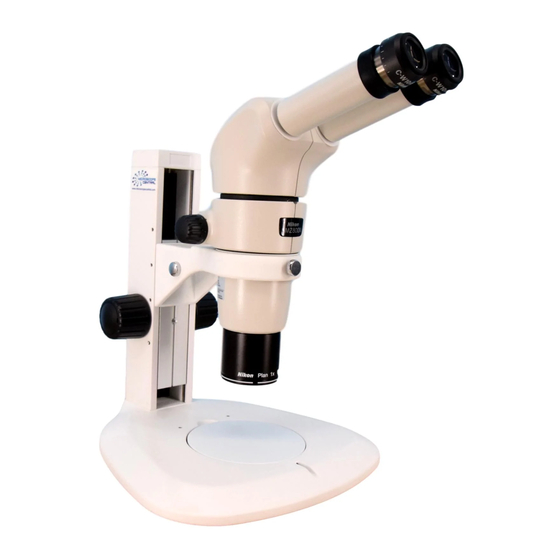
Summarization of Contents
Introduction
Symbols Used In This Manual
Explains symbols used in the manual for clarity.
Safety Precautions
WARNING and CAUTION Symbols
Details the meaning and usage of WARNING and CAUTION symbols for user safety.
Label Attached to the Product
Describes labels attached to products, indicating important usage information.
General Safety Warnings
Covers critical warnings like disassembly, reading manuals, and heat hazards.
General Cautionary Notes
Provides cautionary advice on power, light exposure, heat, and handling.
Handling and Storage Precautions
Advises on careful handling, environmental conditions, and avoiding dust/scratches.
Chapter 1 Components
SMZ800N Zooming Body Systems
Illustrates and labels components of the SMZ800N zooming body system.
SMZ1270 Zooming Body Systems
Illustrates and labels components of the SMZ1270 zooming body system.
Chapter 3 Specific Operations
Turning On the Power
Details the procedure for powering on various microscope system components.
Adjusting the Brightness
Explains how to adjust illumination brightness on different microscope devices.
Switching the Optical Path of the Tube
Describes how to switch the optical path for eyepieces or camera use.
Adjusting the Angle of Depression (Changing the Eye Level)
Guides on adjusting the binocular part's angle for optimal viewing height.
Adjusting the Diopter
Guides on adjusting the diopter for individual eyesight to achieve clear focus.
Adjusting the Interpupillary Distance
Explains how to adjust interpupillary distance for comfortable binocular viewing.
Focusing on the Sample
Details the process of focusing on a sample using focus knobs.
Changing the Magnification
Explains how to change magnification using zoom knobs and objectives.
Switching Objectives (Using a Nosepiece)
Describes how to switch objectives using the nosepiece for different views.
Shifting a Sample
Describes methods for moving the sample on the stage for observation.
Using Episcopic Illumination
Explains how to use episcopic illumination for surface observation.
Using Epi-Fluorescence Illumination
Details the use of epi-fluorescence microscopy, including filter cubes.
Selecting a Filter Cube
Explains how to select and use different filter cubes for fluorescence microscopy.
Important Notes for Epi-Fluorescence Microscopy
Provides key considerations for successful epi-fluorescence microscopy.
Using Diascopic Illumination
Explains how to use diascopic illumination for transparent sample observation.
Capturing Images
Outlines the procedure and tips for capturing images with a camera.
Chapter 4 Functions and Operations of the Devices
Zooming Bodies
Describes the functions and operation of SMZ800N and SMZ1270/1270i zooming bodies.
Focus Mounts
Details the types and operations of C-FMAN, C-FMBN, and C-FMCN focus mounts.
Stands
Explains the features and specifications of various microscope stands.
Stages
Describes different types of stages like XY, Sliding, Floating, and Tilting stages.
Tubes
Details the types and specifications of binocular and trinocular tubes.
Nosepieces
Describes the P-RN2 and P-RNI2 nosepieces and their functions.
Objectives
Lists supported objectives, their specifications, and compatibility.
Episcopic Illuminators
Details various episcopic illuminators like coaxial and fiber types.
Epi-Fluorescence Attachment
Explains the P-EFL epi-fluorescence attachment, filter cubes, and shielding plate.
Control box
Describes the P2-CTLB control box functions and connections.
Other Devices
Covers optional devices like aperture units, beam splitters, and teaching heads.
Chapter 5 Assembly
System Configuration
Provides diagrams showing how different components form a complete microscope system.
Device List
Lists all available devices, their models, and basic system configuration options.
Assembly Procedures
Step-by-step guide for assembling the microscope system and its components.
Chapter 6 Troubleshooting
Image Viewing Issues
Addresses problems related to the field of view, brightness, and image clarity.
Operation Issues
Solves common operational problems like eye fatigue and focus deviation.
Chapter 7 Maintenance and Storage
Cleaning Procedures
Provides instructions for cleaning lenses and other parts of the microscope.
Product Storage Guidelines
Details the correct conditions for storing the microscope to prevent damage.
Chapter 8 Specifications
Microscopy Principles
Explains the basic principles of microscopy and the product's intended use.
Performance Properties
Lists detailed performance specifications for zooming bodies, focus mounts, stands, etc.
Physical Properties
Details operating conditions, dimensions, mass, and safety standards of the microscope.












Need help?
Do you have a question about the SMZ1270i and is the answer not in the manual?
Questions and answers